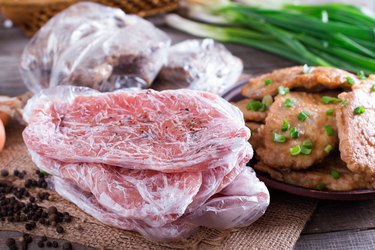
Perhaps you found a good deal on a family pack of chicken breast or a five-pound package of ground beef.
Or maybe you bought some salmon fillets and then realized, after the fact, that you won't be home to cook and eat them within a day or two.
Video of the Day
Video of the Day
Whatever the case may be, freezing meat, poultry and seafood is a fantastic way to keep your proteins fresh and ready for a future meal.
Isn't it great to open the freezer and find pork tenderloin or lamb chops that can be defrosted and ready for dinner without making a trip to the store?
We think so, which is why we put together this go-to guide on how to freeze meat properly and a handy chart to consult when you're wondering how long your future lunch or dinner will last.
Tip
The number one thing to remember when freezing animal-based protein is that it should be divided into portion-sized quantities for packaging. (Psst, here's what servings of meat and seafood actually look like.) For best results, freeze them as soon as you get home with your haul.
What You'll Need to Freeze Meat, Poultry and Seafood
- Plastic wrap ($9.84 per 3-pack on Amazon.com)
- Heavy-duty aluminum foil ($8.49 on Amazon.com) or freezer paper ($13.79 on Amazon.com)
- Resealable freezer bags ($10.49 on Amazon.com)
How to Freeze Meat, Poultry and Seafood
- Open the packaging and split the meat, poultry or seafood into portion sizes or into the amount you would reasonably defrost at a time.
- Wrap each portion with freezer paper or aluminum foil and place into a resealable freezer bag.
- Place each wrapped portion in a resealable bag.
- Label each resealable bag with the name of the item and the date you packed it.
Related Reading
How to Wrap Animal Protein Properly
- To best wrap certain cuts of meat, many use what is called the drugstore wrap, a method similar to wrapping a gift. This method both presses and locks out air, keeping your food extra fresh. Freezer paper is best for this technique, but aluminum foil may be used instead.
- Place food in the center of a sheet of freezer wrap. Note that you may first use plastic wrap to cushion anything that protrudes, such as a bone, before wrapping the whole item.
- Bring the two longest sides together over the food and fold the edges over by about one inch and crease the paper.
- Bring the seam down, pressing it flat against the top of the food.
- Fold the corners of each end toward the center, making a triangle and then press out the air and fold the triangle's tip down flat, toward to the package. Press the end up flat against the package and tape securely with masking tape.
- To pack more than one serving in a package, separate each with freezer paper or aluminum foil. Do not stack more than three inches high per package.
How Long Frozen Meat Lasts
Food | Preparation | Maximum Time Stored |
|---|---|---|
Beef, Veal, Lamb, Pork | Steak | 6 to 12 months |
Beef, Veal, Lamb, Pork | Chops | 4 to 6 months |
Beef, Veal, Lamb, Pork | Roasts | 4 to 12 months |
Beef, Veal, Lamb, Pork | Ground and stew meat | 3 to 4 months |
Chicken or Turkey | Whole | 12 months |
Chicken or Turkey | Parts | 9 months |
Chicken or Turkey | Ground and stew meat | 3 to 4 months |
Meat or Poultry | Sausage | 1 to 2 months |
Lean fish | Fillets or pieces | 6 to 8 months |
Fatty fish | Fillets or pieces | 2 to 3 months |
Shellfish, squid, octopus | Washed and cleaned | 3 to 6 months |
Clams, oysters, scallops | Live in-shell or shucked | 3 to 6 months |
Was this article helpful?
150 Characters Max
0/150
Thank you for sharing!
Thank you for your feedback!